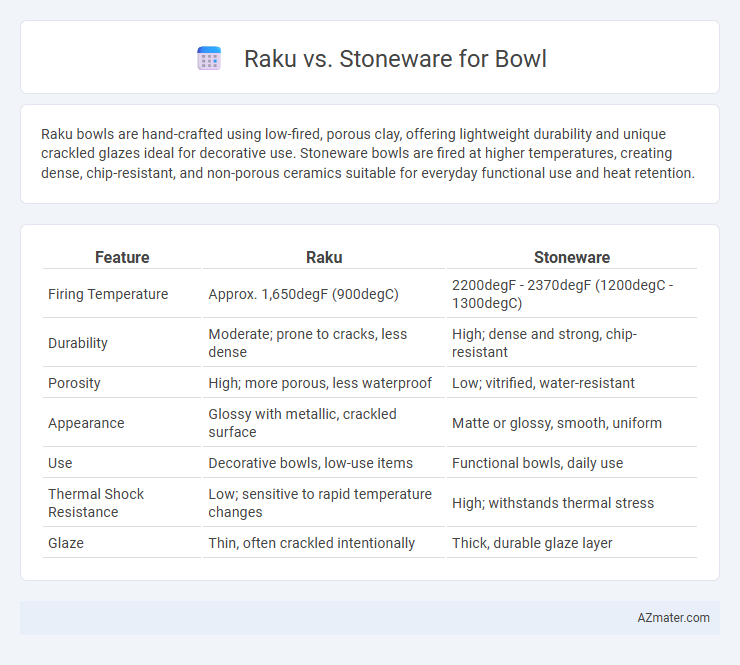Raku bowls are hand-crafted using low-fired, porous clay, offering lightweight durability and unique crackled glazes ideal for decorative use. Stoneware bowls are fired at higher temperatures, creating dense, chip-resistant, and non-porous ceramics suitable for everyday functional use and heat retention.
Table of Comparison
| Feature | Raku | Stoneware |
|---|---|---|
| Firing Temperature | Approx. 1,650degF (900degC) | 2200degF - 2370degF (1200degC - 1300degC) |
| Durability | Moderate; prone to cracks, less dense | High; dense and strong, chip-resistant |
| Porosity | High; more porous, less waterproof | Low; vitrified, water-resistant |
| Appearance | Glossy with metallic, crackled surface | Matte or glossy, smooth, uniform |
| Use | Decorative bowls, low-use items | Functional bowls, daily use |
| Thermal Shock Resistance | Low; sensitive to rapid temperature changes | High; withstands thermal stress |
| Glaze | Thin, often crackled intentionally | Thick, durable glaze layer |
Introduction to Raku and Stoneware
Raku pottery is a rapid-firing technique originating from Japan, prized for its unique crackled glaze and smoky textures created by removing hot pieces from the kiln and cooling them quickly. Stoneware, a durable and dense clay fired at high temperatures, boasts a non-porous surface ideal for everyday bowls with excellent heat retention and strength. Both materials offer distinct aesthetic and functional qualities, making the choice dependent on desired appearance and practical use.
Origins and History of Raku and Stoneware
Raku pottery originated in 16th-century Japan, deeply connected to the traditional tea ceremony and characterized by low-firing techniques that produce unique glaze effects through rapid cooling and reduction processes. Stoneware, with roots tracing back to ancient China and Europe around 3000 BCE, is a durable, high-fired ceramic known for its dense, non-porous body and versatility in crafting functional and decorative bowls. Both Raku and stoneware embody distinct cultural histories and firing methods, influencing their artistic expression and practical use in contemporary ceramics.
Differences in Firing Processes
Raku bowls undergo a unique low-temperature firing process followed by rapid cooling, often involving removal from the kiln while red-hot and exposure to combustible materials for reduction effects. Stoneware bowls are fired at higher temperatures, typically between 1,200degC to 1,300degC, resulting in a dense, vitrified, and durable ceramic body. The contrast in firing regimes produces Raku's porous, crackled surface with organic textures versus Stoneware's hard, non-porous, and consistent finish.
Material Composition and Properties
Raku bowls are crafted from porous clay that is fired at low temperatures and rapidly cooled, resulting in a crackled glaze and lightweight, fragile structure ideal for decorative use. Stoneware bowls are made from dense, non-porous clay fired at higher temperatures, producing a durable, chip-resistant material suitable for everyday functional use. The thermal shock resistance of stoneware surpasses that of raku, making it more practical for food serving and microwave or dishwasher applications.
Aesthetic Appeal and Surface Finishes
Raku bowls exhibit a unique aesthetic appeal characterized by unpredictable crackled glazes and metallic sheens due to rapid cooling, creating one-of-a-kind surface textures that emphasize wabi-sabi beauty. Stoneware bowls offer a more consistent and durable finish with smooth, often matte or glossy surfaces achieved through high-temperature firing, allowing for precise control over color and texture. The choice between Raku and Stoneware surfaces depends on preference for organic, rustic charm or refined, sturdy elegance in ceramic bowls.
Durability and Functional Use
Raku bowls, created through a rapid cooling process, are known for their unique textures and artistic appeal but tend to be more fragile and less durable for everyday use. Stoneware bowls offer superior durability, resistance to chipping, and can withstand high temperatures, making them ideal for functional, daily kitchen use. Compared to raku, stoneware is better suited for practical applications like microwaving, baking, and regular washing without compromising structural integrity.
Suitability for Bowl Making
Raku pottery features a unique firing process that creates crackled textures and vibrant glaze effects, making it highly suitable for decorative bowls but less ideal for everyday use due to its relative fragility and sensitivity to thermal shock. Stoneware offers exceptional durability and resistance to chipping, making it a practical choice for functional bowls that require frequent use and washing. While raku bowls excel in aesthetic appeal and artistic expression, stoneware bowls are preferred for their robustness and suitability for food-safe applications.
Safety, Food Use, and Toxicity Concerns
Raku bowls, often fired at lower temperatures and cooled rapidly, can retain porosity and lead to potential leaching of lead or other harmful metals if not properly glazed, raising safety and toxicity concerns for food use. In contrast, stoneware bowls undergo high-temperature firing (typically 1200-1300degC), resulting in a durable, non-porous, and food-safe surface resistant to chipping and harmful chemical leaching. Ensuring that both Raku and stoneware bowls use FDA-approved, lead-free glazes is crucial to minimizing toxicity risks and maintaining safe food contact standards.
Price and Accessibility
Raku bowls typically command higher prices due to their unique firing process and artisanal nature, making them less accessible for casual buyers. Stoneware bowls offer a more affordable option, widely available in various retail and online stores due to their durable mass-production methods. Consumers seeking budget-friendly and easily obtainable bowls often prefer stoneware over the more exclusive and costly Raku pieces.
Choosing the Right Material for Your Bowl
Raku bowls offer a unique, handcrafted finish with crackled glazes and vibrant colors, ideal for decorative use but less durable for everyday dining. Stoneware bowls provide exceptional strength and chip resistance, making them perfect for regular use and dishwasher safety. Selecting the right material depends on whether you prioritize aesthetic appeal and artistry in raku or durability and practicality in stoneware.

Infographic: Raku vs Stoneware for Bowl
 azmater.com
azmater.com